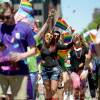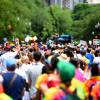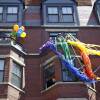Let's take a walk down the block. Today we're starting on Clarendon Street in the South End, where you'll find numerous red brick Victorians and pass people walking their dogs and strollers along the tree-lined streets. And every few blocks, especially this time of year, you'll see a rainbow flag.
“It's not as gay as it used to be, but it still is. The center has the highest percentage, at least of gay men,” said Russ Lopez, an activist and historian who serves on the board of the History Project, a nonprofit in that preserves and shares New England's LGBTQ history. He has lived in the South End for decades.
Gay men began coming to the South End in the 1960s and ’70s looking for cheap housing in what was then considered one of the poorest neighborhoods in Boston, but also one where they could feel safe, Lopez said.
“To me, the big test is whether or not you can hold hands with your partner,” Lopez said. “My husband and I – everybody knows us in the neighborhood and they know that half the time we walk around holding hands. But I don't hold hands when I'm at Downtown Crossing. I wouldn't hold hands when I was at Logan Airport or at the Seaport here. It's very common. You still see it all the time.”
Back in the day, Lopez says, it was common for people to sit on their stoops making passes at their neighbors.
“Half the time someone, I guess, would end up upstairs. It was that kind of place, particularly in the ’80s,” he said. “That began to change with the AIDS crisis — that kind of free-flowing, anything goes kind of thing. It's not nearly as it was in the ’70s and ’80s. So the neighborhood matured. I guess you'd say it got older, whether that's good or bad.”
That also meant the neighborhood became really expensive — something that hasn't changed.
“You can't separate out income and class from what was going on. And that's one reason why this was always much more for gay white men — to a certain extent also Black and Latino men, because of the history of the South End being a place that was also a home for Black and Latino people,” Lopez said.
Lopez added that many lesbians lived in Jamaica Plain and Somerville, and trans people in Allston and Brighton. But for years it was the Boston Pride parade that drew everyone into the city center, and the South End was a key part of it. The first parade was a march in June of 1971. It went down Charles Street through Boston Common and Beacon Hill and ended at City Hall Plaza. By the ’80, it had grown in size and was making its way through the South End with Boston Center for the Arts on Tremont Street at its heart.

“The whole point of this was to have this crowd of people right here with marchers going by and the politicians and the personalities looking down at this thing,” Lopez said. “And everybody would put on their special display. As the pivot point of the parade, this was ground zero. For many years, parts of the South End were thought to be too far out, and not safe enough. But this part of the South End, particularly the blocks behind us, was considered the Gold Coast.”
But this year, for the third time in a row, there won't be a Pride parade .
The reason why is a long story. Here's the short version: In 2020, in addition to the pandemic, the nation grappled with systemic racism. A group of queer activists of color chastised the then-sitting Boston Pride Committee for resisting inclusion within its organization and failing to more strongly support Black Lives Matter and trans women of color. Boston Pride subsequently dissolved in 2021, and in April, it was announced that the parade would not be returning this year.
“I think it's a tragedy. I think it's really sad,” Lopez said. “I had lots of people died of AIDS, for example. And you think about the folks who died before Stonewall, died before marriage was legal, and all these other things, that it seems like it's a way of memorializing them. We didn't leave a lot of legacies. There [are] not statues. There [are] not street names. There's nothing. So a parade kind of shows we exist.”
Lopez said that over time, the Pride parade became diluted by the presence of businesses and corporations, which has become a general criticism of Pride in recent years. There also have been concerns about the heavy police presence at the parade, given the historic criminalization of queer people and people of color.
"And you think about the folks who died before Stonewall, died before marriage was legal, and all these other things, that it seems like it's a way of memorializing them. We didn't leave a lot of legacies... So a parade kind of shows we exist."-Russ Lopez, LGBTQ activist and historian and board member for the History Project
“I don't think it's a bad thing that we don't have a parade this year,” said Joan Ilacqua, the executive director of the History Project. “I think it's terrible in this political climate that there is not one organization that is bringing queer people together to be able to rally around rights for trans people, for trans youth in particular, for education on LGBTQ history and culture, for reproductive rights. I think that's a tragedy. But not having one Pride parade, to me as someone in my 30s, is not that big a deal.”
Ilacqua said Pride, as it was, did not fully include the most marginalized within Boston's queer community. This year's events, such as the Trans Resistance Rally happening in Franklin Park later this month are a way to make them feel seen.
“The Pride parade never went to Jamaica Plain or Roxbury,” Ilacqua said. “The Pride parade was really focused here. And so you can see that your neighbors are friendly here, but what's happening in these other neighborhoods that are so often overlooked?”
Lopez said it's great to hold Pride events elsewhere, but contends it's always been important to have an event close to downtown.
“If we only have LGBTQ events outside of the core, it's almost like saying we don't belong in the core,” Lopez said. “The idea was that by grounding it in downtown central Boston, we were showing we were part of the city, just as important as anybody else.”
One thing Lopez and Ilacqua can agree on — wanting someone to stand up and commit to representing everyone under the Pride umbrella.
Linda DeMarco, the former president of Boston Pride, said there may not be an organization formed yet to put on a Pride parade in Boston, but there's clearly great passion in the LGBTQ community to make an impact so that everyone is welcomed and safe to be their true self.
She also pointed to grassroots groups that are stepping forward to produce programs and events throughout the state. One of them is Trans Resistance, which will hold a rally and march in Roxbury later this month.









